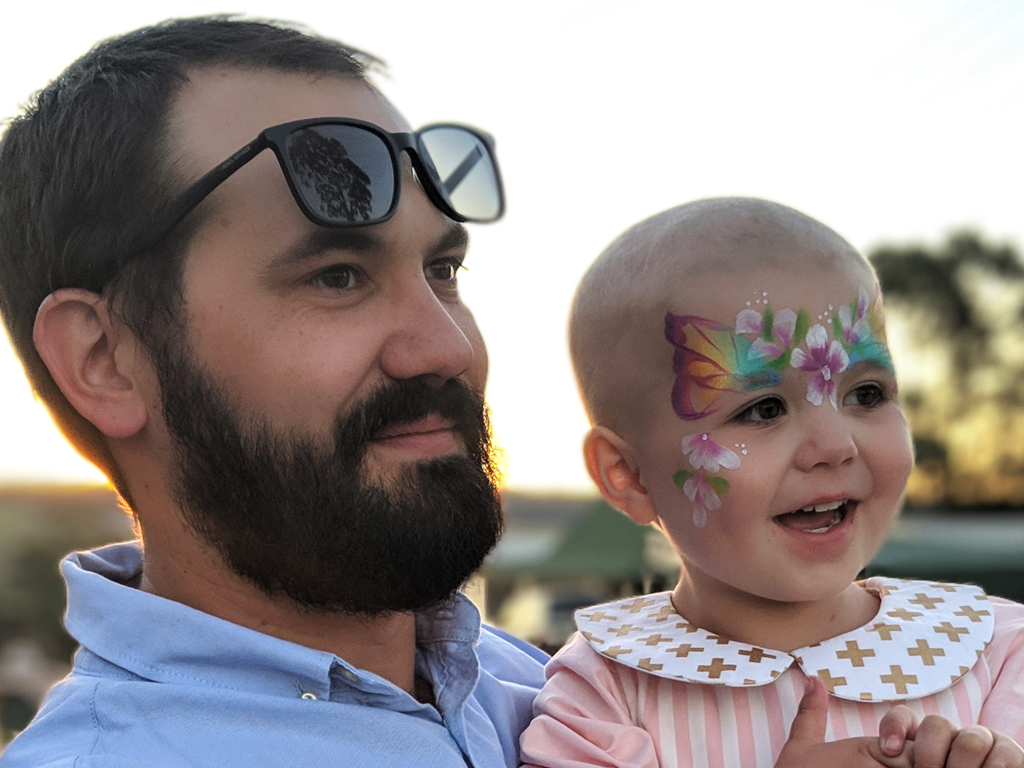I was thinking "they’re all wrong. There’s no way that it’s cancer, there’s just no way. Why?"
- Eliza, Harper’s mum
Harper was not even two years old when a shock diagnosis of acute lymphoblastic leukaemia meant she would end up spending the next year, a third of her short life time, in hospital undergoing gruelling treatment. Thanks to a test developed by Children’s Cancer Institute, her family are hoping she never has to go back.

Before diagnosis
At not yet two years of age, happy and easygoing Harper loved fun family times: playing in the park, walks with the family dog and visits to the beach. Eliza and Darren were like any other parents enjoying life with their first-born child. But within weeks Harper’s life as a care-free toddler took a dramatic turn.

Symptoms
Harper had developed an ongoing chest infection, and just didn’t seem to be getting better. “She was pale and lethargic, and I couldn’t do anything to get her to pick up a bit,” says Harper’s mum, Eliza. The family doctor did a blood test and, within hours, suggested they head straight to the local hospital Emergency. Eight hours later she was at Sydney Children’s Hospital, Randwick.
She was pale and lethargic, and I couldn’t do anything to get her to pick up a bit.
- Eliza, Harper’s mum

Diagnosis
Harper’s blood results showed increasing levels of blast cells, a key indicator of leukaemia. She underwent a bone marrow aspirate and lumber puncture for doctors to confirm the diagnosis as acute lymphoblastic leukaemia. When the formal diagnosis came in the news hit hard.
I pretty much just cried the whole couple of weeks after they told us what they thought it was. It was like a mental car crash.
- Eliza, Harper’s mum

Treatment
The day after diagnosis, Harper had a port inserted in her chest for chemotherapy to be administered, but after the first round, the port became badly infected and she had to be put in isolation. This precious young girl had a wound in her chest so large she had to go under general anaesthetic every time the dressing was changed.
The treatments often triggered high fevers, while Harper’s reaction to steroids led to terrible tempers and occasional “screaming until she fell asleep.” Harper lost muscle in her legs, which meant that she couldn’t walk for a time. As a 2-year-old, such difficult side effects were very hard to understand.
They wheel it in and then, you’ve got one person holding the hands, one person holding the legs, then port access. She put up a good fight during access and de-access. It was so hard seeing her like that.
- Eliza, Harper’s mum
Today
Harper is now three and her intensive treatment has stopped meaning fewer hospital trips. With Harper being able to attend day care once a week, Eliza and Darren are so grateful to welcome a return to their normal family lives. Recently they welcomed a new addition to their family, Adeline, and Harper is loving her new role as big sister.

How you can help

Give a gift
By giving a gift today, you can make a difference to the lives of children with cancer.

Fundraising and events
Get involved in one of our events or create your own to help find better, safer treatments for children with cancer.

Partnerships
Join our diverse community of businesses, philanthropists and gamechangers, determined to help cure childhood cancer.
Share your story
Have you been touched by childhood cancer and would like to share your story? Please get in touch today.














